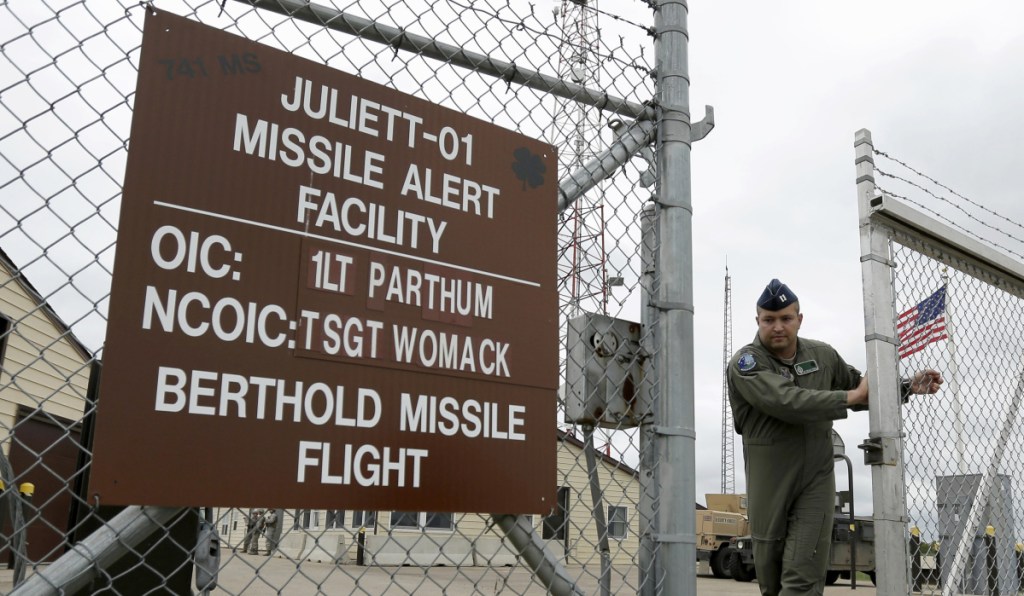WASHINGTON — The Trump administration outlined sweeping changes in U.S. nuclear strategy Friday, calling for two new types of nuclear weapons and warning for the first time that in “extreme circumstances” the U.S. could use nuclear weapons in response to non-nuclear attacks on infrastructure and civilians.
The strategy, described in a 75-page review released by the Pentagon, constitutes one of the most significant revisions of U.S. nuclear strategy since the Cold War, one aimed at aggressively countering nuclear-armed Russia and North Korea as well as terrorist groups seeking to acquire nuclear arms.
By clarifying potential scenarios when the president might authorize a nuclear attack, officials said, the U.S. was seeking to deter adversaries from conducting large-scale cyber warfare and other non-nuclear but potentially devastating attacks on the U.S. and its allies, a controversial idea that critics said could make nuclear war more likely.
“In no way does this approach lower the nuclear threshold,” Defense Secretary James N. Mattis said in a statement accompanying the report. “Rather, by convincing adversaries that even limited use of nuclear weapons will be more costly than they can tolerate, it in fact raises that threshold.”
But Joseph Ciricione, a nonproliferation expert at the Ploughshares Fund, a Washington-based advocacy group that seeks reductions in the nuclear arsenal, said the new strategy – combined with President Trump’s volatile approach to international threats – could lower the threshold for employing nuclear weapons.
“This strategy gives him a massive rebuild of the current Cold War arsenal, complete with new missions and new weapons, to include responding to a cyberattack with a nuclear bomb,” Cirincione said. “This plan, coupled with this president, greatly increases the risk of nuclear war.”
The Obama administration sought to shrink the role of nuclear weapons in U.S. defense strategy.
It declared in 2010 that it would consider using nuclear weapons only in extreme circumstances, such as a massive conventional attack by a nuclear armed state or in the event of a mass-casualty chemical or biological attack.
Trump’s strategy likewise calls for using nuclear weapons only “in extreme circumstances to defend the vital interests of the United States, its allies and partners.”
But it specifies that extreme circumstances also could include “non-nuclear strategic attacks” including those on the “U.S., allied or partner civilian population or infrastructure,” as well as “on U.S. or allied nuclear forces, their command and control, or warning and attack assessment capabilities.”
The review recommends modifying “a small number” of existing nuclear warheads on Trident missiles carried on U.S. submarines to reduce the weapons’ explosive power. In addition, a new nuclear-armed cruise missile launched from naval vessels would be developed, a process likely to take years.
Current and former Pentagon officials said that Russian military doctrine increasingly envisions using a limited nuclear strike to win a conflict in Europe, believing the U.S. and its allies might not want to risk large-scale nuclear war under those circumstances.
The lower-yield warhead for Trident missiles would “ensure a prompt response option” and would help counter any “mistaken perception” by Russia, North Korea or other adversaries that the U.S. might hesitate to respond with nuclear weapons to a limited nuclear strike by one of them, the report said.
Copy the Story LinkSend questions/comments to the editors.



Success. Please wait for the page to reload. If the page does not reload within 5 seconds, please refresh the page.
Enter your email and password to access comments.
Hi, to comment on stories you must . This profile is in addition to your subscription and website login.
Already have a commenting profile? .
Invalid username/password.
Please check your email to confirm and complete your registration.
Only subscribers are eligible to post comments. Please subscribe or login first for digital access. Here’s why.
Use the form below to reset your password. When you've submitted your account email, we will send an email with a reset code.